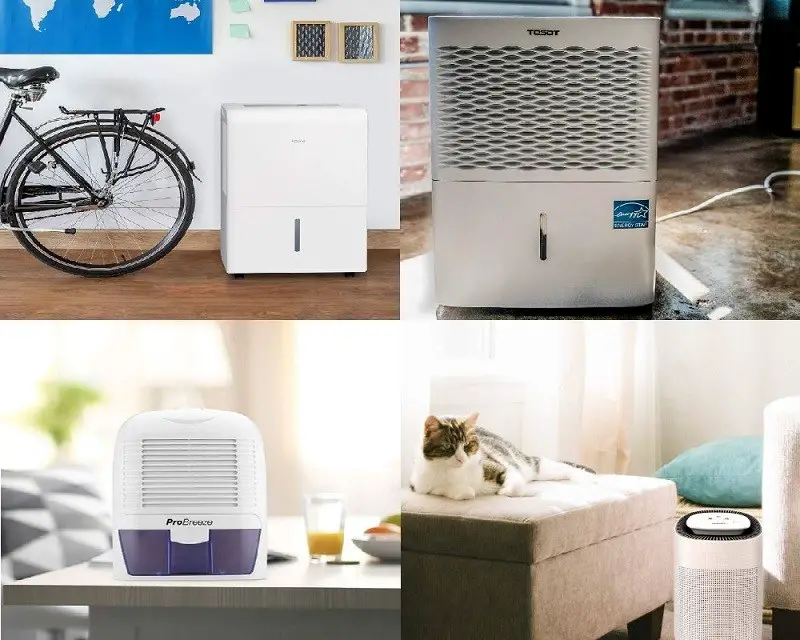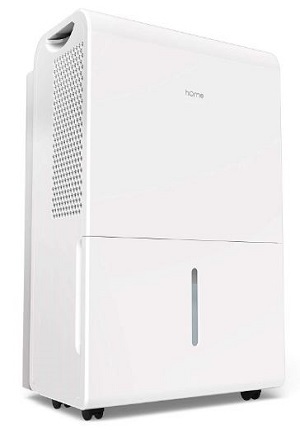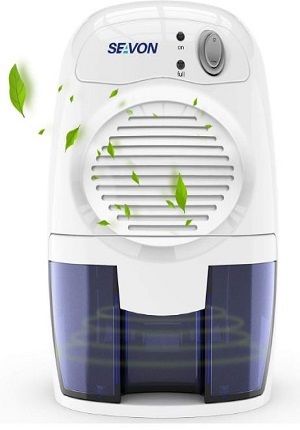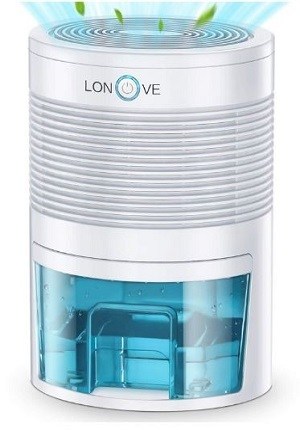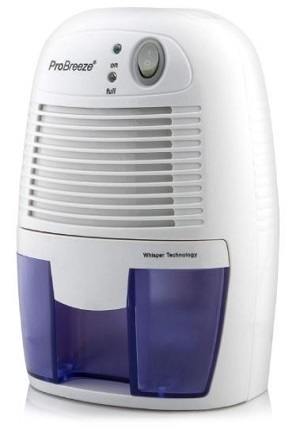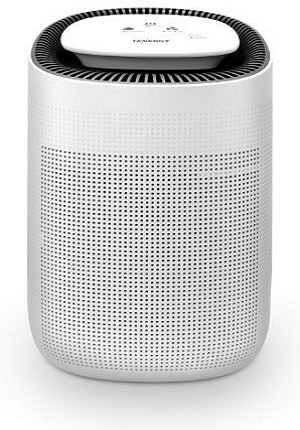Looking for a room dehumidifier?
You’ve come to the right place.
A dehumidifier removes water from the air. It is useful for rooms that tend to get a damp smell such as the laundry room or basement.
You can also use a dehumidifier to improve indoor air quality during, particularly humid weather. This is helpful for allergy and asthma sufferers, as too much moisture in the air can lead to more mold and other allergens.
If you are also looking for a portable air conditioner to cool a room, see our reviews of the best portable air conditioners and the top small/personal portable AC units.
Many of these come with built-in dehumidifiers, though they are not as powerful as a dedicated dehumidifier is.
What’s in This Guide?
In this 15-minute buying guide, we review the best residential humidifiers. We review the different sizes and types of dehumidifiers so that you can find one that’s perfect for your needs.
We will also give you handy tips on how to choose the right dehumidifier based on factors like type, size, noise level, and water removal performance.
Best Dehumidifiers: Comparison Table
Disclaimer: All links below go to Amazon.com
- 1Best for Most Homes: hOmeLabs 1,500 Sq. Ft Energy Star Dehumidifier
- 2Best for the Basement and Extra-large Rooms: hOmeLabs 4,500 Sq. Ft Energy Star Dehumidifier
- 3Best With Pump: TOSOT Energy Star Dehumidifier with Pump
- 4Best for Small Rooms: SEAVON New Electric 2022 Mini Dehumidifier
- 5Best Mini Humidifier for Enclosed Spaces: Eva-dry E-500 Renewable Mini Dehumidifier
- 6Best Non-Electric (Desiccant) Dehumidifier: Eva-dry E-333 Renewable Mini Dehumidifier
- 7Best Peltier (Thermoelectric) Dehumidifier: Pro Breeze Electric Mini Dehumidifier (220 sq. ft.)
- 8Best for RVs: LONOVE Dehumidifier
- 9Best Portable: Pro Breeze Electric Mini Dehumidifier (150 sq. ft.)
- 10Best for Bedroom: Tenergy Sorbi 1000ml Air Dehumidifier w/Air Purifying Function
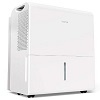
hOmeLabs 1,500 sq. ft. Energy Star Dehumidifier
- Best for most homes
Type:
CompressorWater Removal Rate (2019 DOE Standard):
22 pintsMax Room Size:
1,500 sq. ft.Built-in Pump:
Tank Capacity:
1 gallon

hOmeLabs 4,500 sq. ft. Energy Star Dehumidifier
- Best for basement and extra-large rooms
Type:
CompressorWater Removal Rate (2019 DOE Standard):
50 pintsMax Room Size:
4,500 sq. ft.Built-in Pump:
Tank Capacity:
1.8 gallon

TOSOT Energy Star Dehumidifier with Pump
- Best with pump
Type:
CompressorWater Removal Rate (2019 DOE Standard):
45 pintsMax Room Size:
4,500 sq. ft.Built-in Pump:
Tank Capacity:
Not specified

SEAVON Mini Dehumidifier
- Best for small rooms
Type:
ThermoelectricWater Removal Rate (2019 DOE Standard):
9 ouncesMax Room Size:
175 sq. ft.Built-in Pump:
Tank Capacity:
0.1 gallons
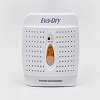
Eva-dry E-500 Renewable Mini Dehumidifier
- Best for small enclosed spaces
Type:
DesiccantWater Removal Rate (2019 DOE Standard):
Not specifiedMax Room Size:
500 cubic feetBuilt-in Pump:
N/ATank Capacity:
N/A
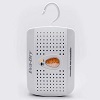
Eva-dry E-333 Renewable Mini Dehumidifier
- Best non-electric (desiccant)
Type:
DesiccantWater Removal Rate (2019 DOE Standard):
Not specifiedMax Room Size:
333 cubic feetBuilt-in Pump:
N/ATank Capacity:
N/A

Pro Breeze electric mini dehumidifier
- Best thermoelectric (Peltier)
Type:
ThermoelectricWater Removal Rate (2019 DOE Standard):
18 ouncesMax Room Size:
220 sq. ft.Built-in Pump:
Tank Capacity:
52 ounces
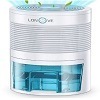
LONOVE Dehumidifier
- Best for RVs
Type:
ThermoelectricWater Removal Rate (2019 DOE Standard):
12 ouncesMax Room Size:
165 sq. ft.Built-in Pump:
Tank Capacity:
27 ounces
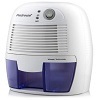
Pro Breeze electric mini dehumidifier
- Best portable
Type:
ThermoelectricWater Removal Rate (2019 DOE Standard):
9 ouncesMax Room Size:
150 sq. ft.Built-in Pump:
Tank Capacity:
16 ounces
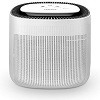
Tenergy Sorbi 1000ml Air Dehumidifier
- Best for bedroom
Type:
ThermoelectricWater Removal Rate (2019 DOE Standard):
25 ouncesMax Room Size:
200 sq. ft.Built-in Pump:
Tank Capacity:
33 ounces
Best Dehumidifiers: Reviews
1. Best for Most Homes: hOmeLabs 1,500 Sq. Ft Energy Star Dehumidifier
Most homes don’t need a 5,000 sq. Ft. Dehumidifier. A small 200 sq. Ft. unit is also inadequate for most people.
The hOmeLabs 1,500 sq. ft. dehumidifier is a great fit for the average room size in most homes.
Whether you need to dehumidify an open plan living room, your bedroom, or a basement, the hOmeLabs dehumidifier is perfect. It removes up to 22 pints of moisture from the air per day.
Pros
- Covers medium size and large rooms.
- Good moisture removal rate.
- Automatic shut-off.
- Continuous draining outlet.
- Wheels and handles for easy portability.
Cons
- No built-in pump.
Our Review
The hOmeLabs 1,500 sq. ft. Dehumidifier is the best fit for most homes.
It is a compressor type of dehumidifier, which means it’s more effective than other types of dehumidifiers, specifically desiccant and Peltier dehumidifiers.
As per the 2019 DOE standard, it removes 22 pints of water per day when set in a continuous mode. This makes it ideal even for most climates, including those with relatively high humidity.
The hOmeLabs dehumidifier has an automatic shut-off function. This prevents water from overflowing out of the 1-gallon water tank.
When the tank fills up, it’s easy to remove and drain (this unit has no built-in pump). If you don’t want to keep draining the tank, connect a 5/8” garden hose to the continuous drain outlet at the back.
The control panel is easy to use. There are only a few buttons for the timer (auto-start or auto-stop), fan control (normal and high modes), and continuous mode. There’s also a small screen displaying current humidity and other settings.
Note that you can turn off the default continuous mode and set your own humidity level using the arrow buttons.
We love how portable the hOmeLabs dehumidifier is. It is fairly large, but the built-in wheels make it easy to move it from one room to another.
Maintenance is straightforward, but you need to do it regularly without fail. Left uncleaned, dehumidifiers can easily harbor mold, bacteria, and other bad stuff.
The manufacturer recommends cleaning the water tanks every couple of weeks and washing the filter once a month.
Specs
Water removal rate: 22 pints
Coverage: 1,500 sq. ft.
Tank capacity: 1 gallon
Dimensions: 15.2L x 10W x 19.7H inches, 30.5lbs
Timer: yes
Pump: no
Continuous drain: yes
Warranty: 2 years (+6 months with registration)
2. Best for the Basement and Extra-large Rooms: hOmeLabs 4,500 Sq. Ft Energy Star Dehumidifier
If you have a damp basement, you’ll need a dehumidifier powerful enough to cover the large space. We recommend hOmeLabs 4,500 sq. Ft. dehumidifier.
It is also a good choice for extra-large rooms and spaces such as an attic, an open loft, or a large open-style living area.
It removes up to 50 pints of water a day.
Pros
- Ideal for large spaces.
- High water removal rate.
- Continuous draining.
- Auto shut-off to prevent overflowing.
- Wheels for easy portability
Cons
- No built-in pump.
Our Review
Most residential dehumidifiers top out at 50 pints of water removal per day. This is equivalent to 70 pints if you go by the Department of Energy’s 2012’s testing standard.
So if you are looking for a dehumidifier that can cover large areas such as a basement, the hOmeLabs 50-pint, 4,500 sq. Ft. dehumidifier is a great choice.
It is big but considering you’ll be using it in a large room, space shouldn’t be an issue.
Like its smaller 1,500 sq. Ft. sibling above, this4,500 sq. Ft. unit runs on a compressor. A Peltier or desiccant dehumidifier can’t work well for a space this big.
When you’ve set it in a continuous mode, it’ll extract about 50 pints of water over 24 hours.
Using the control panel on the unit, you can disable continuous mode and, instead, select your own humidity level. The unit will then maintain that level of humidity.
You can also adjust the fan speed to quickly dehumidify a room or reduce fan noise and set a timer to start or stop the dehumidifier automatically.
4,500 sq. Ft. dehumidifier comes with a 1.8-gallon tank to store the collected water. Since it lacks a built-in pump, you have to either drain the tank manually or connect a hose to the continuous drain outlet.
Maintenance is similar to the smaller hOmeLabs dehumidifier: wash the water tank every fortnight and clean the filter monthly.
The hOmeLabs dehumidifier comes with a 2-year warranty, and you get 6-months extra coverage if you register your unit on their official website.
Specs
Water removal rate: 50 pints
Coverage: 4,500 sq. ft.
Tank capacity: 1.8 gallons
Dimensions: 15.4L x 11W x 24.3H inches, 40lbs
Timer: yes
Pump: no
Continuous drain: yes
Warranty: 2 years (+6 months with registration)
3. Best With Pump: TOSOT Energy Star Dehumidifier with Pump
Having to drain the water tank manually is tedious and inconvenient. A dehumidifier with a built-in pump makes maintenance much easier. Just connect a hose, and the pump does the rest. And unlike gravity drains, you can set up the hose to drain water vertically.
The TOSOT Energy Star Dehumidifier is our top pick for those looking for a dehumidifier with a pump.
Pros
- Built-in drain pump.
- The drain line is included.
- Ideal for most homes – covers up to 4,500 sq. Ft. spaces.
- High water removal rate (45 pints) – ideal for basements and other high-humidity spaces.
- Quiet.
Cons
- Internal humidity monitor is inaccurate.
Our Review
The built-in pump is the biggest selling point of the TOSOT dehumidifier. It is one of the best low budget dehumidifiers available in market that saves you from the trouble of lifting a tank full of water, and provides especially big advantage for older users.
Another advantage is that the drain hose doesn’t have to slope downwards for water to drain since the dehumidifier is not relying on gravity. This gives you more flexibility over how and where to set up the dehumidifier.
You can even drain the water upwards into the kitchen sink if you don’t have a floor drain.
Having the built-in pump aside, TOSOT is definitely one of the best inexpensive dehumidifier available in the market. With a maximum coverage of 4,500 square feet, it meets the needs of most homes.
It removes up to 45 pints of water per day, making it ideal for high-humidity environments such as the basement.
TOSOT is one of the quietest humidifiers you’ll find with the lowest fan setting producing only 48 decibels of sound. That’s equivalent to a quiet hum, inaudible when you are watching TV or talking to someone.
Higher fan settings are only slightly louder – 50 and 52 decibels. So even at the highest setting, you can still watch TV or carry on a conversation.
The TOSOT dehumidifier has a filter to make sure it blows out clean air free of dust and most allergens. The filter is washable. A light will come on after about 250 hours of operation to remind you to clean the filter.
The unit is fairly big and heavy – it weighs 40lbs – but you’ll never have to lift it. It has wheels for easy portability between rooms.
Overall, TOSOT is a solid choice for most homeowners and apartment dwellers. The only complaint we (and most customers) have is the inaccurate humidity monitor.
If you measure with your own hygrometer, you’ll discover the TOSOT dehumidifier is about 10% off. When the relative humidity is 50%, the unit displays a reading of 60%.
Keep this in mind when setting humidity levels. Set it 10% higher than what you want it to be.
Specs
Water removal rate: 45 pints
Coverage: 4,500 sq. ft.
Tank capacity: Not specified (Note: Thanks to the built-in pump, tank capacity is not essential)
Dimensions: 14.8L x 11.4W x 24.1H inches, 48lbs
Timer: yes
Pump: yes
Continuous drain: yes
Warranty: 1 year
4. Best for Small Rooms: SEAVON New Electric 2022 Mini Dehumidifier
The SEAVON mini dehumidifier is designed for areas up to 170 square feet, making it perfect for the home office, small bedrooms, and bathrooms.
You can also use it in an RV, a storage room, or inside a closet. The Peltier dehumidifier removes up to 9 ounces of water a day.
Pros
- Compact design – perfect for small spaces.
- Auto shut-off.
- Very quiet.
- Easy to maintain.
Cons
- Limited water removal rate – it can take days to achieve the preferred humidity level.
- Works best in very small rooms (smaller than the specified 170 sq. ft.).
Our Review
Compressor dehumidifiers are great but can be an overkill in small spaces. You don’t need a unit that removes 50 pints of water in your small bathroom or home office.
A smaller – and cheaper – dehumidifier will work just as well, albeit more slowly.
The SEAVON mini humidifier’s compact size makes it perfect for small rooms. You can set it right on the table or on a shelf. It doesn’t take up much space.
It is a Peltier or thermo-electric dehumidifier. This type of dehumidifier works much slower than a compressor type. So don’t expect a workhorse.
The SEAVON dehumidifier extracts just 9 ounces of water from the air per day. This may not sound like much, but over 2-3 days, you’ll notice a difference in the room.
If you want to be sure it’s working, buy a hygrometer and monitor the room’s humidity over time.
Most customers use it in their bathrooms to dry the air quicker, get rid of the damp smell, and prevent mold growth. Others use it as a personal dehumidifier next to their bedside or work desk.
The collection tank is small – just 500ml (0.1 gallons). But because the dehumidifier collects only a little water every day, it takes time to fill up.
When it fills up, an auto switch-off function prevents the tank from overflowing. An LED indicator will also come on, telling you to drain the tank.
Considering the size of the SEAVON dehumidifier, it’s no surprise that it has no drain mechanism – whether it’s a pump or a gravity drain outlet. The only way to empty the tank is to take it out and pour the water.
An obvious downside with the SEAVON mini dehumidifier is its limited performance. The manufacturer says you can use it in a room up to 175 square feet. But customers say it works best in a room smaller than that, ideally less than 100 sq. Ft.
It’ll still dehumidify a larger room, but it’ll take days.
Specs
Water removal rate: 9 ounces
Coverage: 175 sq. Ft.
Tank capacity: 0.1 gallons (500ml)
Dimensions: 7.2L x 6.2W x 11H inches, 2.4lbs
Timer: no
Pump: no
Continuous drain: no
Warranty: 1 year
5. Best Mini Humidifier for Enclosed Spaces: Eva-dry E-500 Renewable Mini Dehumidifier
If you want to dehumidify a small enclosed space such as a closet, under the sink, or a small crawlspace, we recommend the Eva-dry E-500 mini dehumidifier.
It is a desiccant dehumidifier, meaning it doesn’t need any batteries or power connection. This gives you the flexibility to put it just about anywhere you’d like less moisture.
Pros
- Uses renewable desiccant.
- No batteries or power needed.
- Easily fits in small spaces.
- Lasts 10 years.
Cons
- Limited water removal – only ideal for very small spaces.
- Beads take long to recharge.
Our Review
The Eva-dry E-500 is one of the best low price dehumidifiers that uses silica beads to dehumidify a space. The beads absorb water from the surrounding air.
Unlike a conventional dehumidifier, there’s no tank to hold the collected water. The beads hold on to the water instead. No worries about overflowing or spills. You also don’t have to think about draining a tank.
The beads have a limited water-holding capacity. They change color as they hold more water.
The beds start out orange then turn to green when they are full of water. This takes about 3-8 weeks, depending on ambient conditions.
When the beads turn green, it’s time to renew them.
You do this by plugging the dehumidifier into a power strip in a well-ventilated area. The manufacturer is very specific on using a power strip. Don’t plug it into a wall outlet.
When you plug it in, a built-in heater warms the beads, expelling the water inside. After 12-14 hours, the beads should turn back to orange.
However, some users say it can take as long as 48 hours to renew the beds, especially if you wait too long to renew them after they turn green.
The manufacturer does not provide a specific water removal rate. But it’s likely just a few ounces a day.
That’s why we recommend using the E-500 only in small rooms and spaces. The maximum recommended space you can use it in is 500 cubic feet.
It’s perfect for kitchen pantries (the desiccant is odorless and non-toxic), storage closets, gun safes, boats and RVs, cabinets, and safe deposit boxes.
You can also use it to dehumidify your car.
Specs
Water removal rate: Not specified
Coverage: 500 cubic feet
Tank capacity: n/a
Dimensions: 8L x 2.5W x 5.5H inches, 1.8lbs
Timer: no
Pump: no
Continuous drain: no
Warranty: 5 years
6. Best Non-Electric (Desiccant) Dehumidifier: Eva-dry E-333 Renewable Mini Dehumidifier
The Eva-dry E-333 is similar to the E-500, only smaller and cheaper. It’s the best choice for people who want to try a non-electric dehumidifier.
Like the E-500, the E-333 is ideal only for small rooms and spaces. Think closets, pantries, RVs, and bathrooms – any space that’s no bigger than 333 cubic feet.
Pros
- Ultra-compact design – perfect for small spaces.
- Renewable desiccant.
- Eco-friendly.
- Easy to maintain – no filter to clean and no tank to drain.
Cons
- Limited water removal performance.
- Gets hot when recharging. Beads can melt if left plugged in for too long.
Our Review
A desiccant dehumidifier provides an easy way to dehumidify any space without worrying about access to an outlet.
Sure, a non-electric dehumidifier like the E-333 won’t absorb as much water as a plug-in dehumidifier. But it’s not designed to extract a lot of water.
It works best in small spaces such as supply closets, gun safes, lockers, and cars.
The E-333 is one of the best low cost dehumidifiers that uses silica gel crystals to absorb water and hold it within them. This means there’s no tank you need to drain.
But you’ll need to renew the crystals once they reach their water-holding capacity. You’ll know when it’s time to renew the dehumidifier when the beads turn from orange to green.
A small window at the front allows you to observe the beads. On average, it takes 20-30 days for the beads to change color.
When they turn green, plug the dehumidifier into a wall outlet for 8-10 hours. This will dry out the crystals and return them to their dry orange color.
Be careful not to leave the dehumidifier plugged in for too long as it can get hot and cause the crystals to melt.
If, after 10 hours, they have not completely turned orange, leave the dehumidifier unplugged for a few hours then plug it in again.
As long as you recharge the dehumidifier on time, it can keep going for up to 10 years.
Specs
Water removal rate: Not specified
Coverage: 333 cubic feet
Tank capacity: n/a
Dimensions: 9L x 8.2W x 2.9H inches, 1lb
Timer: no
Pump: no
Continuous drain: no
Warranty: 5 years7. Best Peltier (Thermoelectric) Dehumidifier: Pro Breeze Electric Mini Dehumidifier (220 sq. ft.)
If you want to dry a small room or space, a thermoelectric or Peltier dehumidifier is cheaper and uses less power than a compressor type dehumidifier.
The Pro Breeze electric mini dehumidifier is one of the most popular and highest rated thermoelectric dehumidifiers.
Pros
- Best affordable dehumidifier – much cheaper than a conventional dehumidifier.
- Auto shut-off to prevent overflowing.
- Much quieter than a compressor dehumidifier.
- Compact and lightweight.
- Removes 1-2 cups of water from the air daily.
Cons
- It doesn’t dry as effectively or as quickly as a conventional dehumidifier.
- It doesn’t work if the temperature drops below 41F.
Our Review
The Pro Breeze electric mini dehumidifier relies on the Peltier effect to turn humidity into liquid water.
The Peltier effect describes the change in temperature that occurs when voltage flows in a circuit with two different types of conductors. The circuit gets cool on one side and hot on the other, essentially acting as a heat pump.
The Pro Breeze dehumidifier passes air over the cool side, which causes moisture in the air to condense and turn into liquid water.
Using this method, Pro Breeze can remove up to 18 ounces – about two and a quarter cups – of water from the air every day within a 220 sq. Ft. room.
It has a 52-ounce internal tank that holds the water. When it fills up, the dehumidifier will automatically shut off to prevent overflowing an indicator will come on, alerting you to drain the water.
To drain, you remove the tank and pour out the water. There’s no option to connect a drain line.
The Pro Breeze thermoelectric dehumidifier is perfect for small spaces such as a bathroom, a small bedroom, an apartment, or a closet. It’s also great for RVs, and you can even use it to keep your car’s interior dry if you live in a humid area.
Note that Pro Breeze works much slower than a compressor dehumidifier. It may take a few days to get rid of the damp smell from a room. But once the worst of the moisture is gone, the small unit does a great job keeping the space dry.
Just remember to empty the tank often. If you live in a high-humidity area, you may need to empty it daily.
Something else to note is that the Pro Breeze dehumidifier doesn’t work in any temperature. The optimal range is 59-86F. If the temperature falls below 41F, it won’t dehumidify.
The temperature limitation is because of how the Peltier effect works. It depends on the ambient temperature.
Specs
Water removal rate: 18 ounces/day
Coverage: 220 square feet
Tank capacity: 52 ounces
Dimensions: 6.6L x 9W x 12.7H inches, 5lbs
Timer: no
Pump: no
Continuous drain: no
Warranty: 1 year
8. Best for RVs: LONOVE Dehumidifier
For RVs, a thermoelectric dehumidifier is better than a conventional compressor-type dehumidifier. A thermoelectric dehumidifier can easily handle the small space, it’s ultra-quiet, and it doesn’t take up much space.
We recommend the LONOVE Dehumidifier. It is a compact dehumidifier that can remove up to 350ml of moisture per day.
Pros
- Cheap Dehumidifier.
- Takes up very little space in your RV.
- Decent moisture removal rate.
- Quiet.
- Auto shut-off.
Cons
- Operates best within 59-104F.
- Works slowly and is limited only to small spaces.
Our Review
The LONOVE Dehumidifier is really small, just 11.1” high and 6.3” long. You can place it on a desk, on your bedside table or on a shelf.
This makes it perfect for space-limited RVs. You don’t need to make space for a large and bulky compressor dehumidifier.
Lonove is meant to dehumidify rooms up to 165 square feet in size, which makes it ideal for smaller campers or a partitioned room in an RV.
It removes 350ml or about 12 ounces of moisture from the air per day. But the temperature must be right for the dehumidifier to work well – this is an inherent limitation of thermoelectric/Peltier dehumidifiers.
The manufacturer recommends a temperature range of 59-104F. Relative humidity should also be above 50%.
A built-in, 27-ounce tank holds the condensed water. A water level controller automatically shuts off the dehumidifier when the tank fills up, and a yellow tank-full indicator lights up.
Like most compact Peltier dehumidifiers, Lonove has no drain port. To drain the tank, you have to remove it from the dehumidifier and pour out the water. It’s a 1-minute process.
In addition to RVs, the Lonove dehumidifier is also ideal for small spaces such as closets, kitchen pantries, under the sink. You can also use it to dehumidify a small room.
Specs
Water removal rate: 12 ounces/day
Coverage: 165 square feet
Tank capacity: 27 ounces
Dimensions: 6.3L x 5.2W x 11.1H inches, 2.9lbs
Timer: no
Pump: no
Continuous drain: no
Warranty: 2 years
9. Best Portable: Pro Breeze Electric Mini Dehumidifier (150 sq. ft.)
This Pro Breeze electric mini dehumidifier is a smaller version of the 220 sq. Ft. Pro Breeze mini dehumidifier we’ve reviewed above. This one is lighter and more compact, making it perfect for those who want a portable dehumidifier.
Pros
- Cheap.
- Highly portable.
- Decent water removal rate.
- Auto shut-off.
- Ultra-quiet.
Cons
- Limited to very small spaces.
- Works within a specific temperature range.
Our Review
Pro Breeze dehumidifiers are, clearly, some of our favorites. This 150 sq. Ft. one is small and light enough that you can stuff it in a bag and carry it in your car when you go camping or on a road trip.
With a maximum coverage of 150 square feet, it can dehumidify even a large tent, as long as you keep all flaps closed. No more hot and humid camping trips.
It also works great in a car, truck, or RV.
The Pro Breeze dehumidifier is a thermoelectric type, meaning it’ll take some time to notice a difference. It removes roughly 9 ounces of water a day.
It’s not much, but it makes a difference within a small space.
It comes with a 16-ounce tank that you’ll need to take out now and then for draining. The dehumidifier has an auto shut-off feature, so don’t worry about water overflowing. An LED indicator will tell you when the tank is full.
Like other thermoelectric dehumidifiers, Pro Breeze is limited to a specific temperature range: 59-86F. If temperatures go below 41, it won’t work.
Specs
Water removal rate: 9 ounces/day
Coverage: 150 square feet
Tank capacity: 16 ounces
Dimensions: 7L x 6W x 11H inches, 2.4lbs
Timer: no
Pump: no
Continuous drain: no
Warranty: 1 year10. Best for Bedroom: Tenergy Sorbi 1000ml Air Dehumidifier w/Air Purifying Function
A dehumidifier fits best for use in the bedroom that should be quiet, which gives thermoelectric dehumidifiers like the Tenergy Sorbi an edge over the noisier compressor-style dehumidifiers.
There’s another reason you should get Sorbi for your bedroom: it has a built-in HEPA air purifier. No more stuffy nose or itchy eyes when you sleep.
Pros
- 2-in-1 dehumidifier and air purifier.
- Ultra-quiet thermoelectric dehumidifying technology.
- Compact – takes up little space on your bedside.
- Auto shut-off with tank-full indicator.
Cons
- You need to replace the HEPA filter twice a year.
- Works within a limited temperature range.
Our Review
To be clear, the Tenergy Sorbi dehumidifier does not replace a dedicated air purifier. If you have serious allergies, odor sensitivity or asthma, get a full-size HEPA air purifier (see our reviews of the best air purifiers for smoke and other allergens).
But if you are only mildly sensitive to dust mites or pollen and your home has low levels of air pollutants, then the Tenergy Sorbi might be enough.
The air purifier built into the unit uses a true HEPA filter. That means it can capture allergens and pollutants as small as 0.3 microns.
The only downside of having a HEPA air purifier conveniently bundled into a dehumidifier is that you essentially have two appliances to maintain. The HEPA filter needs to be replaced every 6 months.
Tip: There have been reports of the manufacturer running out of replacement filters. Buy several of them to be safe.
The air purifier aside, the dehumidifier is also quite impressive. It is a Peltier-type dehumidifier, which makes it much quieter than conventional dehumidifiers.
It removes about 25 ounces – roughly 3 cups – of water per day from the air. Its optimal coverage is 200 sq. Ft. or less, which covers the size of most bedrooms.
The condensate goes into a 33-ounce tank, which has an auto shut-off function when it fills up. An LED light will also come on to alert you.
For the dehumidifier to work best, make sure ambient temperature is above 50F.
The Tenergy Sorbi dehumidifier is compact and light. You can easily move it to other rooms such as the home office, another bedroom, the bathroom, or any other small space you want to dehumidify.
Specs
Water removal rate: 25 ounces/day
Coverage: 200 square feet
Tank capacity: 33 ounces
Dimensions: 8.5L x 7.7W x 12.4H inches, 6lbs
Timer: no
Pump: no
Continuous drain: no
Warranty: 2 years (when you register)
Why You Need a Dehumidifier

Obviously, not everyone needs a dehumidifier. If you live in a dry climate, a dehumidifier is going to make the air even drier.
But if you live in a humid area such as near the ocean, a lake, or a river, the high levels of moisture in the air can cause various issues.
For one, it’ll lower air quality, making breathing harder. This gets worse if it is also hot.
High levels of humidity also encourage mold, mildew, and other allergens, which can affect people with allergies and asthma.
Too much moisture can also damage furniture, wallpaper, flooring, and other furnishings.
High humidity levels are not just a problem for people in certain climates and regions. Basements in any location tend to have lots of moisture in the air as water from the surrounding ground seeps in.
If your roof is leaking or there’s a plumbing problem, you may also experience high levels of moisture in certain rooms.
A dehumidifier extracts some of the moisture from the air, which improves indoor air quality, reduces levels of allergens, and prevents damage to furnishings and items like books.
Types of Dehumidifiers
Here are the most common types of dehumidifiers.
Compressor Dehumidifiers

Compressor dehumidifiers are the most common types of dehumidifiers. They are also the most effective, especially for large rooms.
A compressor dehumidifier works much like your kitchen fridge. A refrigerant cools a plate or coils. Then a fan draws air in the room over the cold coils, causing moisture in the air to condense into liquid water.
The water is collected in a tank or drained away through a drain tube.
Because compressor dehumidifiers can move a lot of air and make the coils very cold, they are the most effective at drawing moisture from the air.
If you live in a very humid area or need to dehumidify a large room, definitely go with a compressor dehumidifier.Pros
- Can remove more water than other types of dehumidifiers (between 20 and 50 pints, based on new DOE testing standards).
- Ideal for large rooms and high humidity areas.
- Most offer the option of continuous drainage, which makes maintenance easy.
Cons
- They are the most expensive types of dehumidifiers.
- Most are large and heavy, though many come with wheels for easier portability.
Thermoelectric Dehumidifiers
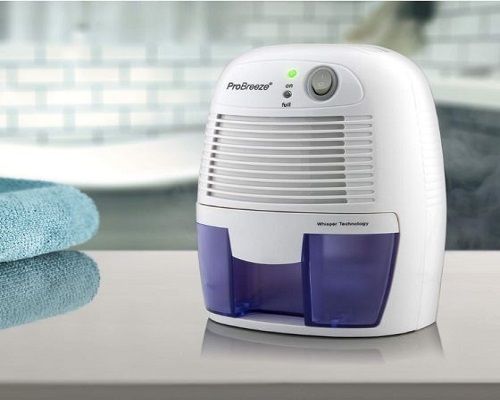
Thermoelectric dehumidifiers are also called Peltier dehumidifiers. That’s because they rely on the temperature difference that occurs in a circuit with two different conductors when current runs through it, what’s called the Peltier effect.
Thermoelectric dehumidifiers remove far less water than compressor dehumidifiers – typically between 9 and 30 ounces. For this reason, they are most suitable for small rooms and spaces – ideally under 200 square feet.
If you want to dehumidify your small bedroom, home office, or bathroom, a Peltier dehumidifier is the best. It’s also great for RVs, closets, and other enclosed spaces.
A thermoelectric dehumidifier has just one major moving part, a small fan that draws air into the unit. This makes them much more reliable and easier to maintain compared to a compressor dehumidifier.
They are also very quiet.
Pros
- Cheaper than compressor dehumidifiers.
- Ultra-quiet.
- Reliable.
- They use less power.
Cons
- Not ideal for large rooms.
- They work slowly, removing only a few ounces of water a day.
- Smaller ones require manual draining daily or every few days.
- They work within a specific temperature range.
Desiccant (non-electric) Dehumidifiers
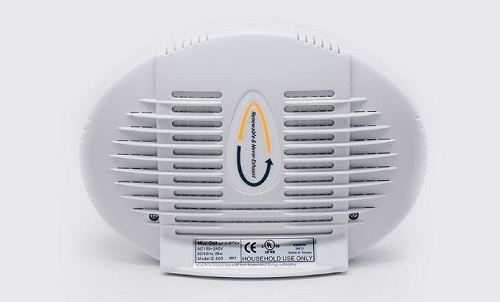
Desiccant dehumidifiers are the only dehumidifiers that don’t need electricity. That means you can place the dehumidifier just about anywhere.
You’ve probably seen this type of dehumidifier in small ‘DO NOT EAT’ sachets included with shoes and some electronics.
Desiccant dehumidifiers contain a substance, the desiccant, that absorbs water from the air. Most use silica crystals as the desiccant.
The crystals hold the water, so there’s no need for drainage. However, you’ll need to renew or recharge the dehumidifier when the crystals change color. This is usually done by plugging the dehumidifier into an outlet.
A small heater inside the dehumidifier heats the crystals to get rid of the water inside.
Desiccant dehumidifiers remove even less water than thermoelectric dehumidifiers. They are ideal for very small spaces such as a closet, a food pantry, a gun safe, or a storage box.
Pros
- They are best cheap dehumidifiers.
- Versatile – you can place a desiccant dehumidifier anywhere without worrying about access to an electrical outlet.
- No draining required.
Cons
- They remove very little water from the air, making them ideal only for small enclosed spaces.
Buying Guide: What to Consider When Choosing a Dehumidifier
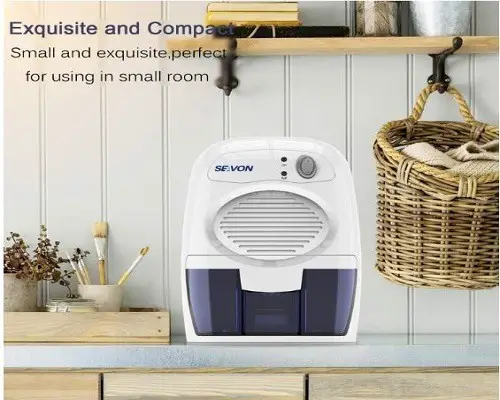
Type
See our explanation of the different types of dehumidifiers above.
If you want to dehumidify a large room or you live in a high-humidity area, get a compressor dehumidifier. It removes the most amount of water in the air.
If you want to dehumidify a small room or you are on a budget, get a thermoelectric/Peltier dehumidifier.
If you want to keep an enclosed space such as a closet, storage box, or gun safe dry, get a desiccant dehumidifier.
Water Removal Rate
The water removal rate is the amount of water a dehumidifier can extract from the air over 24 hours.
It depends on several factors, including the power of the dehumidifier, ambient temperature, and, most importantly, the type of dehumidifier.
Compressor dehumidifiers can remove up to 50 pints of water per day whole Peltier, and desiccant dehumidifiers remove only a few ounces.
If there’s a lot of humidity in the room or you want to dehumidify a large room, get a dehumidifier with a high water removal rate.
Note: Water removal rates are based on new standards by the DOE. Dehumidifiers that were previously rated at 70pints/day are now rated at 45 or 50 pints. Those rated at 30 pints are now rated at around 20 pints/day.
Options and Settings
Fan speed: Adjustable fan speed allows you to increase or lower power levels depending on how much humidity is in the room. It also lets you reduce the noise level.
Auto mode: Some dehumidifiers have an auto mode that automatically starts or stops the fan, depending on humidity readings. Dehumidifiers with an auto mode use less power since the fan only runs when necessary.
Timer: This is another handy energy-saving feature to look for. You can set the dehumidifier to turn off automatically after several hours. Most timers also offer an auto-on scheduling option.
Size and Weight
Next, consider the size and weight of the dehumidifier.
A compact dehumidifier takes up less space in a small room or RV. A lighter dehumidifier will be easier to carry up the stairs. If you want a dehumidifier you can travel with, it should be light and small.
If the dehumidifier you have your eye on is large and heavy, make sure it has caster wheels to make it easier to move from one room to another.
Drainage Options
Check what drainage options the dehumidifier offers.
Large compressor dehumidifiers typically offer three options: removing the tank and manually pouring the water out, continuous gravity drainage, or continuous pump drainage.
Manual drainage is tedious, but at least you don’t have to set up any hoses. This gives you the freedom to set up the dehumidifier wherever you want.
On the downside, you have to monitor the water level in the tank constantly. If you leave the unit unchecked, it will shut off automatically when the tank fills up.
Most dehumidifiers offer a continuous gravity drainage option in addition to manual draining. You connect a hose to a drain port and direct the water to a floor drain or container.
Make sure the hose slopes downwards so that the water drains by gravity.
A few dehumidifiers come with a built-in pump for drainage. You still need to connect a hose, but it doesn’t have to slope.
A dehumidifier with a pump is handy if the only place you have to drain the condensate is a sink. The pump will push the water upwards.
Auto Shut-off
For thermoelectric and compressor dehumidifiers, auto shut-off is a must-have feature. It prevents water from overflowing when the tank fills up.
Auto shut-off turns off the dehumidifier until you empty the tank. If it did not, the overflowing water can damage the dehumidifier and flood your floor.
Dehumidifiers: Frequently Asked Questions

Do dehumidifiers warm a room?
A dehumidifier produces air that is slightly warmer than the one that went in. So, yes, a dehumidifier can warm a room though the effect may be too mild to notice.
However, a dehumidifier can have the opposite effect. High levels of humidity attract warm air and make the room feel hot and clammy.
So dehumidifying a room can make it feel cooler.
Do you need an air conditioner when using a dehumidifier?
Because a dehumidifier doesn’t significantly affect room temperature, you’ll still need an AC to make the room cooler.
In fact, a dehumidifier makes an AC more efficient since dry air is easier to cool. If you have a portable AC that runs until a certain humidity level is achieved, a dehumidifier will make it turn off earlier, thus saving power.
How to take care of a dehumidifier?
Drain and clean the water tank once every one or two weeks. This prevents mold and bacteria from developing in the tank.
If your dehumidifier has a filter, wash it as often as the manufacturer recommends.
Do dehumidifiers use a lot of electricity?
The electricity consumption of a dehumidifier depends on the type, design, and how often you use it.
Compressor dehumidifiers typically use the most power. Leaving your dehumidifier all day will also use more power.
Look for dehumidifiers with an Energy Star. They are the most energy-efficient. Features like auto mode and timer also reduce power consumption.

